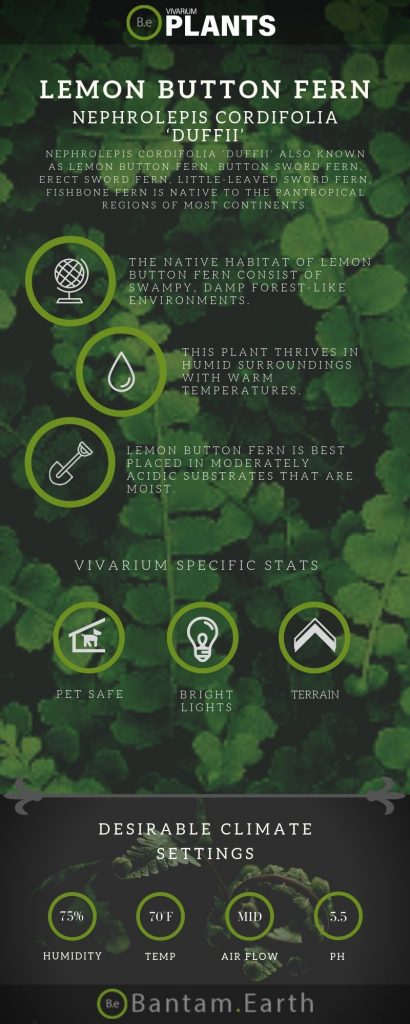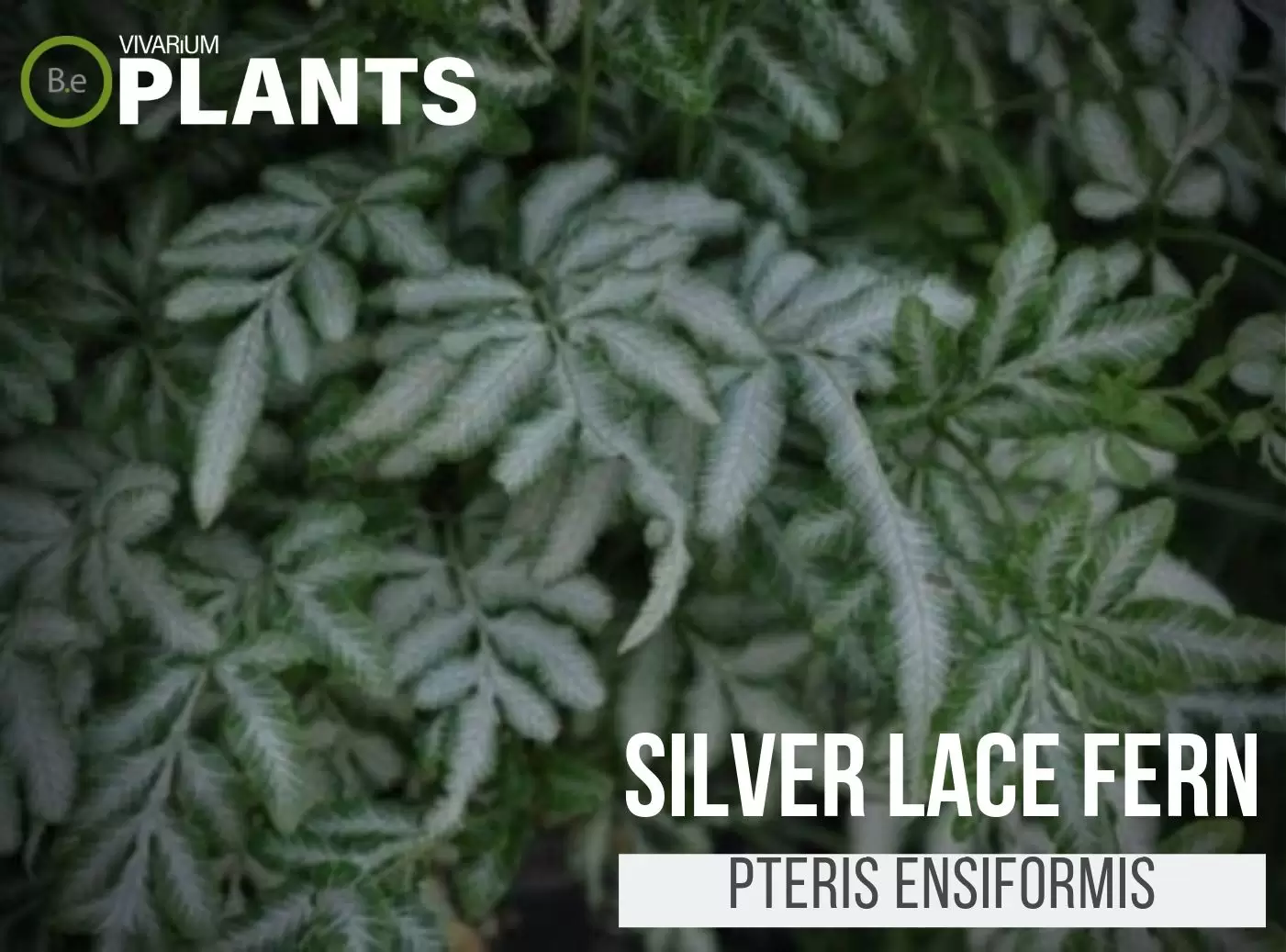When it comes to dressing up a vivarium, the right type of foliage can make all the difference.
The Lemon Button Fern is one of the best plants to have in an enclosure.
It is a relatively small terrarium fern and once its care cycle is established, this plant is pretty much carefree.
Not only is it one of the simpler ferns to grow in a vivarium, but it is also very easy to reproduce.
For these reasons along with its attractive look, many hobbyists use the Lemon Button Fern as an ornamental element in their tanks.
Table Of Contents:
ToggleWhat Is Lemon Button Fern?
Lemon Button Fern is the smallest selection of Boston also scientifically known as Nephrolepis cordifolia ‘duffii’.
Unlike Boston Ferns, this plant normally grows no larger than about a foot tall.
As the name suggests, this flora is part of a group of plants called ferns.
Ferns are vascular plants that reproduce through spores and do not have seeds or flowers.
Instead, they have particular tissues that carry nutrients and water.
This plant is a terrestrial flora that can be grown outdoors in pantropical climates.
However, it has become one of the easiest and most preferred plants to use in vivariums going for a tropical appearance.


Lemon Button Fern Facts
Besides Lemon Button Fern, Nephrolepis cordifolia ‘duffii’ is also commonly known as Button Sword Fern, Erect Sword Fern, Little-leaved Sword Fern, and Fishbone Fern.
Interestingly enough, the leaves of this plant release a lemony fragrance when handled or crushed.
This quality easily explains the rather fitting choice of name for the fern.
It is a relatively easy plant to take care of and does not require a whole lot of maintenance.
For this reason, Lemon Button Fern is a great plant for beginners to use.
They are not known for dropping their leaves or easily turning brown and have much less demanding water requirements compared to other ferns.
Description
Lemon Button Fern is a medium-sized fern known for its golden-green foliage that releases a lemon-like aroma.
It will grow to about a foot high and not much more in width.
Small, round, and serrated leaves grow on each side of the plant’s arching fronds.
Many people claim the alternating leaves resemble little buttons.
Like many other ferns, Nephrolepis cordifolia ‘duffii’ has a shallow root system better known as rhizomes.
Rhizomes are clumps of wiry stems that grow beneath the surface of a plant and allow it to absorb all the nutrients needed from the substrate.
These rhizomes are also used by plants to store energy since they are thicker than above-ground stems and under the soil where they are more protected from fluctuating temperatures.
Habitat
Lemon Button Fern is a species of plant native to pantropical regions of Asia, Australia, the West Indies, Florida, Central America, and South America.
It loves semi-shady and moist locations, which is why it is usually found in swamps and forests.
Like its counterpart, Boston Fern, this plant is usually found in well-drained and moist soil in areas of medium to high humidity.
Nephrolepis cordifolia ‘duffii’ thrives best at 65 to 75 degrees Fahrenheit.
However, it can survive temperatures as low as 55 degrees Fahrenheit for short periods of time.
PH Preference
Ferns, in general, prefer shady locations that have an acidic substrate.
Soil with a PH of 7 is considered neutral.
A pH below 7 is acidic and a PH above 7 is alkaline.
Lemon Button Fern is not the exception; however, it can still tolerate slightly neutral levels without seeing many negative effects.
Ideally, it prefers a low PH level of 4.0 to 7.0.
Vivarium Type
The Lemon Button Fern will do great in a variety of vivarium types.
In fact, many people have reported having a higher success rate when growing the plant within an enclosure as opposed to outdoors.
When deciding if rather or not to use this plant in a particular type of enclosure, be sure to go with setups that have tropical/moist terrain areas.
Here are recommended vivariums this fern will do well in:
- Paludariums – Half aquatic/ half terrain-based enclosure.
- Terrariums – Fully terrain-based enclosures with little to no aquatic features.
Vivarium Placement
Lemon Button Fern is a terrain-based plant. With that in mind, it should never be placed either partially or fully submerged in water.
Letting this fern sit in stagnant water or soil that is too wet will cause it to drown and die.
Therefore, any location that is higher up in a vivarium is preferred.
Nephrolepis cordifolia ‘duffii’ can be placed in a bucket-like structure towards the top of an enclosure and allowed to grow freely.
Since it is not a very large fern nor does it grow too quickly, it will not need a large amount of space to be appreciated.
Overall, they can really add a tropical feel to a tank due to their leaf structure and the ability to give a naturalistic appearance.
For optimal growth and health, it will be best to place it somewhere high in humidity.
Substrate
When it comes to the substrate, Lemon Button fern does best in rich, moist, and slightly neutral to acidic terrarium soil.
Providing this plant with the right substrate can be the difference in vibrant or dull-looking foliage.
Combining equal parts of coco fiber soil, peat moss, and perlite has proven to be a highly successful mix for this fern.
The peat moss will help maintain damp soil, while the perlite provides that much-needed drainage.
A lack of appropriate drainage can lead to rotting roots and eventually the plant’s death.
It is also important to keep in mind that this fern should not be buried too deep in the substrate.
The soil should cover up all of the rhizomes, but leave the top of the crown above.
Otherwise, this plant will get crown rot and not make it through.
Lighting
Nephrolepis cordifolia ‘duffii’ prefers a semi-shaded environment without much direct sunlight.
Exposing the plant to direct sun for too long will burn the plant and cause the leaves to turn brown.
When setting up lighting inside of a vivarium, LED will work extremely well.
Try to go for cooler colors that resemble a partially shaded day.
Avoid any type of light that has high levels of UV rays.
If the vivarium will not have any artificial lighting, place the vivarium near a window that is bright enough, but also does not get too much direct sun.
Buy Lemon Button Fern
When shopping for possible Lemon Button fern, expect a few key indicators you are buying the best quality plant.
The fern should be free of any bugs or pests.
The source of the fern will usually be sold in small or large garden pots, ready for you to propagate.
In addition, the purchased fern should be green, vibrant, and healthy-looking.
Try to avoid any browning or wilting leaves.
Those are usually signs of poor health and could make it harder for the plant to survive.
Click the image below to find out more about the current price and other relative info on Nephrolepis cordifolia ‘duffii’:




Lemon Button Fern Care and Propagation
Lemon Button Fern is a plant that does not require much care and maintenance once it has already settled.
Still, there are a few things that should always be kept in mind to give this fern the best chance at success.
An adequate amount of water and lighting will help make sure Nephrolepis cordifolia remains strong and vivid.
Removing dead fronds and periodically trimming will also be extremely beneficial for this type of plant.
How to grow
The easiest way to propagate Lemon Button Fern inside an enclosure will be through the process of division.
The rhizomes of the plant should be carefully separated creating smaller individual chunks.
Avoid breaking off or damaging any roots, since that will shock and possibly kill the fern.
Then take the new pieces and plant them at a different location.
Make sure the substrate is rich and moist.
Do not add too much water and make sure that there is proper drainage.
If done correctly, the new ferns should begin growing quite fast.
Nephrolepis cordifolia can also be propagated by spores, but this method is a lot harder to use inside a tank and does not always have a high success rate.
Watering
Unlike most ferns, Lemon Button Fern does not tend to be as sensitive to watering routines.
Nonetheless, the plant does require moist and well-drained soil.
The best watering scenario for this fern would be to provide water once the top two inches of soil have begun to dry out.
Even though Lemon Button Ferns like lots of moisture, be sure not to over-water the plant.
If the soil becomes, sodden, and completely saturated for long periods of time the fern will die.
Another tip would be to add water around the edge of the center to avoid the water becoming stagnant in the middle, which may also cause roots to rot.
Plants Similar To Lemon Button Fern
Adding diversity to an enclosure is key to an aesthetically pleasing vivarium.
Try mixing up the look of your tank with different flora that can easily co-exist in the same types of environment.
Sticking to only one type of plant inside of a tank can take away from a more realistic look.
Furthermore, if for some reason you find this fern hard to acquire or would like to consider something similar to this plant…
Here are some other plants you might find may do well with or in place of Nephrolepis cordifolia:
Conclusion
There it is… Short and sweet beginners guide to owning and caring for a Lemon Button Fern.
Whether you are new to the hobby or experienced in the field, Duffii is a great choice to go with.
Not only does it have vibrant foliage, but it is also not very demanding.
We must also not forget the amazing and fresh lemony aroma that it will fill the enclosure with.
Now, what do you think about this fern?
Have you ever considered using it as a terrarium plant?
If so, what is your favorite quality of the plant?
Frequently Asked Questions
The Lemon Button Fern (Nephrolepis cordifolia ‘duffii’) is a popular houseplant that requires moderate levels of care. To keep your fern happy and healthy, follow these simple guidelines:
• Place in bright, indirect light. The fern prefers bright, indirect light, and will do best when protected from direct sunlight.
• Provide adequate humidity. The Lemon Button Fern is native to tropical climates, and therefore needs slightly higher levels of humidity. Increase humidity by grouping plants together, misting the foliage daily, and using a pebble tray beneath the fern.
• Keep soil evenly moist. Lemon Buttons are surprisingly drought tolerant, but will do best when the soil is kept evenly moist. Feel the soil before watering and only water when the top inch of soil is dry.
•BONUS- Fertilize monthly. Use a diluted liquid fertilizer once a month during the growing season to promote healthy growth.
The tips of Nephrolepis cordifolia ‘duffii’ turning brown is often caused by underwatering, over–fertilizing, or a combination of both. Make sure the soil is moist but not soggy and avoid over–fertilizing. Poor soil drainage and temperature extremes can also contribute to the problem. If the browning persists, you may need to repot the plant in fresh soil with proper drainage.
No, lemon button ferns do not smell like lemons. The plant is named for its chartreuse–colored swirls of wavy fronds, rather than for its scent.
Yes, Lemon Button Ferns are recognized as one of the top air–purifying houseplants by NASA. The plant‘s small, finely cut fronds make it an attractive option while its air–purifying abilities help to remove toxins like formaldehyde and benzene from the air.
No, Lemon Button Fern is not toxic to pets, according to the ASPCA. The Lemon Button Fern is considered a safe plant to have around cats and dogs.





